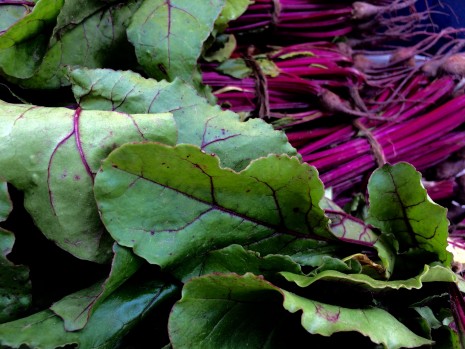SHY-SMILE BEET GREENS: A MARKET STORY
The beet greens I typically encounter at farmers markets play second fiddle to the actual beets. That stands to reason: Most people regard the thick leaves as something to be discarded, asking the seller to remove them before tucking the shorn, diminished root vegetables into a market bag. I have viewed this phenomenon with puzzlement for ages; in fact, it inspired my very first blog post five years ago.
But the Queens County Farm Museum, which sells a beautiful, bountiful array of vegetables, herbs, and cut flowers at the Union Square Greenmarket on Fridays, is bucking the tide, or at least smartly selling the thinnings. (Beets aren’t happy when overcrowded; the edible roots need room to expand into orbs underground.) The Farm Museum occupies New York City’s largest remaining tract (47 acres) of undisturbed farmland; with a history that dates back to 1697, it’s the longest continuously farmed site in New York State. And taking pride of place this past Friday were gorgeous beet greens tethered to vestigial beets by long magenta stems.
That evening, raw beet greens (along with the stems and the teensy beets, scrubbed and sautéed for a nanosecond) stood in for salad, and all I did was add some crumbled Gorgonzola dolce and a drizzle of walnut oil.
Beet greens really come into their own when cooked—they turn lush and silken—but they do shrink down. The next evening, when we had a last-minute dinner guest, they would have made a mingy side, so I channeled the American food writer and bon vivant Eugene Walter, who advocates serving beet greens as a first course in his Hints & Pinches, a chatty compendium originally published in 1991.
“Most people don’t know what the greens are,” Mr. Walter wrote. “Many have simply never tasted beet greens! Such exclamations of joy and mystified enquiries!”
He felt that steamed fresh young beet greens with unsalted butter, salt, and freshly ground black pepper belonged in the same category as the first wild asparagus in Italy and the first young sorrel leaves in France. He served them in individual ramekins with a little tray passed around full of toppings: crumbled crisp bacon, toasted pine nuts, toasted almonds, strips of country ham. With a perfectly straight face, he’d tell his guests that they were eating a form of Turkish cabbage, for instance, or Provençal kale. Only later did he fess up. Sometimes one must tell the plain truth when first asked, then embroider every subsequent version, he explained. But sometimes myth or invention should come first, truth emerging with a shy smile at the end.
Shy-Smile Beet Greens à la Eugene Walter
Pick over your beet greens. Take out older, more wrinkled or yellow leaves. Cut off from roots. Wash in many waters. Tear up, don’t cut. Put in steamer basket, don’t pack too tightly.
Sprinkle a few celery seeds [or not], a light twinkle of freshly ground pepper. Steam until just tender, turning once or twice. Mix with dollops of unsalted butter and hurry to table while hot. Pass a basket of lightly toasted English muffins cut into fingers and a selection of accents as related above.
Posted: June 16th, 2015 under cooking, favorite books, Market Stories, people + places, recipes, spring.


